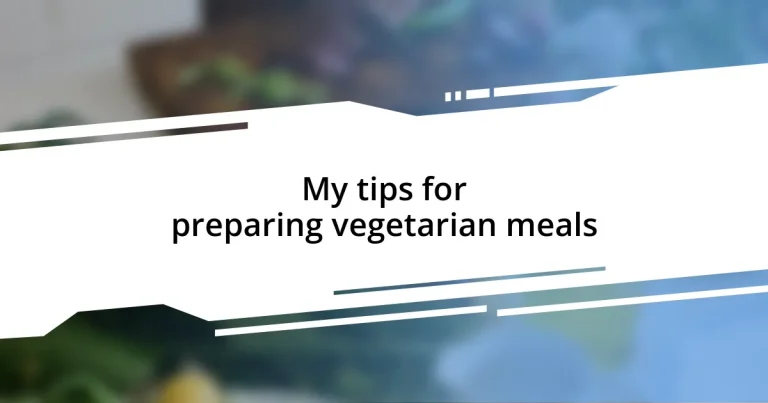Key takeaways:
- A vegetarian diet focuses on plant-based foods, requiring attention to nutritional balance for key elements like protein and iron.
- Choosing fresh, seasonal ingredients enhances flavor and nutritional value, significantly improving meal quality.
- Meal planning streamlines cooking, reduces food waste, and encourages the exploration of new recipes and cooking techniques.
- Proper storage and reheating methods are essential for maintaining the freshness and quality of vegetarian meals.

Understanding Vegetarian Diet Basics
A vegetarian diet primarily excludes meat, but it can encompass a range of foods, including vegetables, fruits, grains, legumes, nuts, and dairy. I still remember the first time I attended a potluck where a friend brought a mushroom risotto. It was so delicious that I thought, “Wait, I might actually prefer this to meat!” It’s fascinating how a simple dish can shift your perspective on vegetarian meals.
There are various types of vegetarian diets, such as lacto-vegetarian (which includes dairy), ovo-vegetarian (which includes eggs), and ovo-lacto vegetarian (which includes both). When I tried ovo-lacto vegetarianism for a month, I found a myriad of egg-based recipes that completely changed my breakfast routine. Have you ever considered how versatile eggs can be? They can transform a mundane meal into something special.
Understanding the nutritional aspects is crucial, too. A well-planned vegetarian diet can meet all your nutritional needs, but it requires attention to sources of protein, iron, and other vitamins. I once experienced fatigue after neglecting my iron intake, which taught me the importance of balancing those nutrient-rich foods. It’s a delicate dance, but with a bit of knowledge, it becomes a fulfilling and vibrant way to eat.

Choosing Fresh Ingredients
Choosing fresh ingredients is essential for creating vibrant vegetarian meals. I remember wandering through the local farmer’s market on a sunny Saturday morning, where the burst of colors from fresh produce was simply intoxicating. The crisp greens and ripe tomatoes practically beckoned to be part of a delicious dish. When I select my ingredients, I look for items that are in season – they not only taste better but also offer more nutrients.
Here are some key tips for selecting fresh ingredients:
- Inspect for Vibrancy: Choose bright, colorful fruits and vegetables; dull colors often indicate overripeness.
- Touch Matters: Gently squeeze items like avocados and peaches to feel for ripeness; firmness can signify freshness.
- Check for Imperfections: While minor blemishes are acceptable, steer clear of anything that looks overly bruised or wilting.
- Smell the Goodness: Aromatic herbs and spices can enhance flavors. Trust your nose—fresh ingredients have a distinct, pleasant scent.
- Local is Best: Whenever possible, opt for local produce. Not only is it fresher, but it also supports the community and sustainability.
Choosing the right ingredients can make all the difference, transforming a simple dish into something incredibly satisfying. I still recall making a caprese salad with tomatoes that had been picked just hours before. The flavors were so much more pronounced than anything I’d ever purchased at a store. This taught me that freshness truly elevates the entire experience of cooking and eating.

Meal Planning Tips for Vegetarians
Meal planning is a game-changer for vegetarians. It can transform a week of nightly dread over “What’s for dinner?” into a smooth, enjoyable process. I specifically plan my meals on Sundays, often while sipping coffee and flipping through my favorite cookbooks. I love taking this time to explore new recipes, paired with seasonal produce that excites my taste buds. Have you ever noticed how planning meals can not only streamline your week but also inspire you to try something new? This simple act of organizing can lead to delightful culinary adventures.
I recommend making a grocery list based on your plan, which saves time and minimizes waste. When I first used this method, I was surprised by how much food I stopped throwing away. Instead of random items languishing in my fridge, I had just what I needed for the week. Plus, I find it helpful to batch-cook meals. Preparing larger portions isn’t only practical; it often leads to deepening flavors when they sit and meld together. Using leftovers creatively—like turning grilled veggies from one night into a flavorful wrap the next—can keep things exciting and cut down on prep time.
Finally, don’t forget to incorporate a variety of protein sources; this keeps your meals interesting and nutritionally balanced. I really love quinoa and beans. They’re versatile and fill me up in a way that’s both satisfying and healthy. Once, I whipped up a quinoa salad with roasted chickpeas, and it has since become a staple in my meal rotation. Exploring different plant-based proteins can not only enhance your meals but also broaden your palate.
| Meal Planning Tip | Details |
|---|---|
| Plan Ahead | Spending time on Sundays helps streamline the cooking process. |
| Create a Grocery List | Focuses your shopping and reduces food waste. |
| Batch-Cook | Prepare larger portions for leftovers and deeper flavors. |
| Diverse Proteins | Incorporate various sources like beans and quinoa for balance. |

Easy Recipes for Beginners
When it comes to easy vegetarian recipes for beginners, I often turn to my go-to dish: a stir-fry. The beauty of a stir-fry is that it’s entirely customizable. I like to toss in whatever veggies I have on hand—bell peppers, broccoli, or even snap peas work wonderfully. Here’s a tip: sauté everything quickly over high heat to retain that wonderful crunch. Don’t forget to add some soy sauce or teriyaki for flavor; it elevates the dish without any fuss.
Another dish I adore is a simple vegetable pasta. I usually start by cooking whole wheat pasta, which adds extra fiber. Once it’s ready, I throw in whatever seasonal veggies I find—zucchini and cherry tomatoes are my favorites. To bring it all together, I drizzle some olive oil and sprinkle parmesan or nutritional yeast for that cheesy flavor. I remember the first time I made this dish; it felt like a mini celebration at my dinner table, and it took less than 30 minutes!
One of the easiest recipes that have won over my friends is a hearty black bean soup. I combine canned black beans, vegetable broth, diced tomatoes, and lots of spices like cumin and chili powder. I let it simmer for about 15-20 minutes. The first time I made this, I was surprised at how a simple soup could warm my heart and fill my belly so quickly. You see, cooking doesn’t have to be complicated to be satisfying. What quick meals have you been craving that could become your new favorites?

Cooking Techniques for Vegetarians
When it comes to cooking techniques for vegetarians, one method I truly enjoy is roasting. There’s something magical about tossing veggies with a little olive oil and seasoning and then letting the oven work its magic. Just the other day, I roasted a medley of carrots, sweet potatoes, and Brussels sprouts, and the flavors that developed were simply divine. Have you ever experienced that satisfying crunch paired with a lovely caramelization? It can turn humble ingredients into something truly spectacular.
Another technique I often rely on is sautéing, especially when I’m in a hurry. I recall one evening when I had little time but wanted something wholesome. I grabbed some spinach, garlic, and cherry tomatoes, sautéed them in a bit of olive oil, and within 10 minutes, I had a vibrant side dish that was bursting with flavor. It reminded me that sometimes, simplicity leads to the most delightful results. Sautéing is fast, and it retains the vibrancy of the vegetables while ensuring they still pack a nutritional punch.
Lastly, don’t overlook the art of seasoning. I’ve learned that herbs and spices can elevate a dish from ordinary to extraordinary. For instance, adding fresh basil to a simple marinara can infuse the sauce with a refreshing twist that makes it unforgettable. I once made the mistake of being a little too timid with herbs, and I couldn’t understand why my meals felt flat. Have you ever felt that way? Learning to play around with flavor combinations has made cooking such an exciting adventure for me—each meal turns into a new exploration!

Flavor Enhancements and Spices
One of my favorite ways to enhance flavors is by experimenting with spices. I remember the first time I added smoked paprika to a dish; the aroma was intoxicating, and the smoky flavor transformed my plain chickpeas into a savory delight. Have you ever tried adding unexpected spices to staple ingredients? It’s like uncovering a layer of depth that you didn’t know existed, making your meals feel more complex and satisfying.
Another element I rely on is fresh herbs—they can ignite any dish! I often keep a small herb garden on my windowsill. Just last week, I snipped some fresh cilantro to top off a veggie taco I made. The moment I took my first bite, the bright, earthy notes of the cilantro elevated every flavor on my plate. This kind of freshness is often missing in pre-packaged meals, don’t you think? Incorporating fresh herbs not only brightens the palate but also adds a personal touch that makes your cooking stand out.
Additionally, I find that acid often plays a crucial role in rounding out flavors. A splash of lemon juice or a drizzle of balsamic vinegar can make such a difference. Just the other night, I prepared a quinoa salad and thought it was good but somehow incomplete. After a squeeze of lemon, it was like everything fell into place. It’s fascinating how a simple acid can harmonize the flavors in a dish. Have you noticed how a little brightness can take your meals from good to great?

Storing and Reheating Vegetarian Meals
Storing vegetarian meals properly is key to maintaining their freshness and nutrients. I usually place my leftovers in airtight containers right after cooking, which helps lock in flavor and moisture. Have you ever opened the fridge, only to find stale food that lost its appeal? Trust me, a little investment in good containers can make all the difference.
When it comes to reheating, I’ve found that the method can really influence the texture and taste of the meal. Microwaving can sometimes make veggies soggy, so I like to use the stovetop instead. Just the other day, I reheated some roasted vegetables in a skillet to bring back their crispness. The transformation was remarkable—I could almost taste that fresh garlic and rosemary as if I had just cooked them! How do you typically reheat your meals? I find that a few minutes on the stove can breathe new life into leftovers, reminding me that they can be just as delicious as when they were first made.
I also like to consider the best time frame for storing vegetarian meals. Most cooked dishes are safe in the fridge for about three to four days. I remember discovering some forgotten pasta primavera in my fridge a week later, and it was less than appetizing. Instead of waiting too long, I now make it a habit to label my containers with dates. It’s a simple trick that prevents food waste and helps me know what to enjoy next! Do you think knowing about storage can help you reduce waste in your kitchen? It certainly has for me; by being mindful, I can enjoy every delightful bite!












